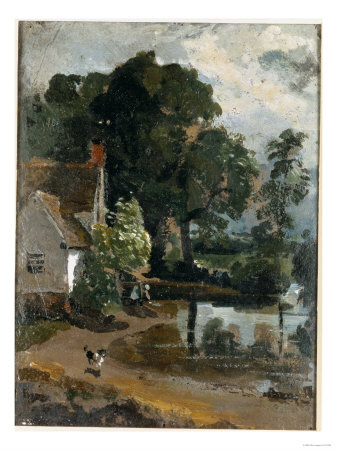John Constable painted Flatford Mill at East Bergholt between 1816 and 1817. In doing so, he immortalised the early C18th Suffolk watermill which once belonged to the Constable family and which now belongs to the National Trust and is one of its most visited attractions in the United Kingdom.
In addition to the mill, his family owned a dry dock where barges, which used to carry goods from country to town before good roads existed, would have been both built and repaired. Constable produced many sketches and finished paintings taking as his subject the Stour, the river close to which he spent a happy childhood.
In common with most other artists of his period, John Constable regularly sketched out of doors but usually completed the works he intended to exhibit in his studio. In 1814, however, he announced his intention to do more painting out of doors and Flatford Mill is both the largest and one the first of these canvases to be painted directly in front of the subject.
At 1016 x 1270 mm, working on the canvas outside 'en plein air' must have been a considerable challenge and although he produced several large-scale outdoor paintings, the artist returned to mainly studio work when he left Suffolk to live in London after 1818. Flatford Mill did not sell at its first exhibition. Subsequent X-ray examination shows that Constable made some changes to it in his studio before it was placed on public display a second time when it was received more favourably.
Some preliminary sketches for the composition still exist and show Constable's interest in and engagement with life by the water. In this painting, which has the alternative title Scene on a Navigable River, Constable depicts an everyday occurrence on a working navigation. In the far distance is the lock, used to raise and lower the passing river traffic.
The lock gates are closed and two barges, possibly a pair, are approaching Flatford footbridge which is just visible on the left of the painting. Barges would be drawn along by horses such as the one seen standing on the towpath.
The horse would not, however, be able to pull the barge through the bridge, so as the bargee manoeuvres his craft into position a boy is preparing to use the rope he has untied from the horse to pull or 'warp' the barge under the bridge manually. Once through, the horse would be re-attached, and the barge would continue its journey.
Natural light floods the painting from the realistically painted summer sky and the blue reflected in the water adds to the effect of lightness. At a time when more dramatic depictions of nature were common, Constable's realism was comparatively unusual and did not receive universal acclaim, but he made a modest living from his work and was elected as a Royal Academician in 1829 when he was 52.
Flatford Mill was never sold and is now owned by the Tate and exhibited in London.




